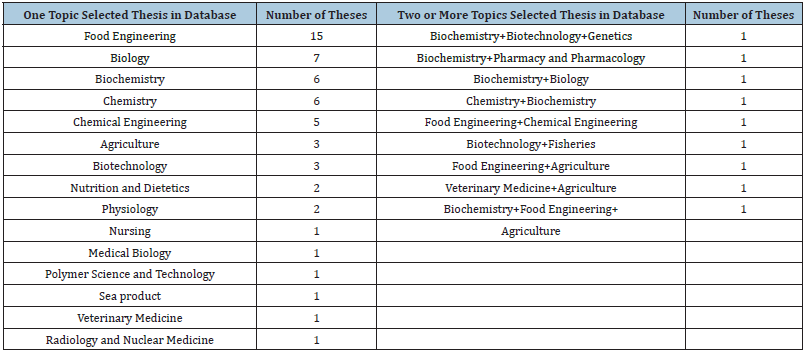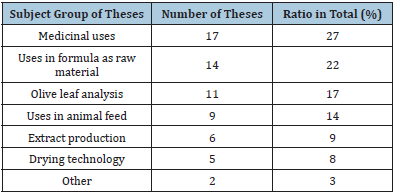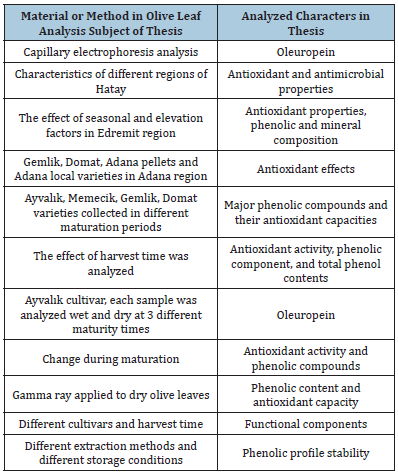- Submissions

Full Text
Novel Techniques in Nutrition and Food Science
Subject Assessment of Postgraduate Theses Relating to Olive Leaf Between 2000-2019 Years in Türkiye
Yasin Ozdemir* and Seda Kayahan
Ataturk Horticultural Central Research Institute, Food Technologies Department, Yalova, Türkiye
*Corresponding author:Yasin Ozdemir, Ataturk Horticultural Central Research Institute, Food Technologies Department, Yalova, Türkiye
Submission: January 30, 2023;Published: March 31, 2023

ISSN:2640-9208Volume7 Issue1
Abstract
The aim of this study is to investigate postgraduate theses about olive leaf in Turkey between 2000-2019. There were 58 master’s degrees, 5 doctorates and 1 expertise in medicine theses (total 64 postgraduate theses). It was determined that olive leaf theses with a single subject entry constitute 86% of the total theses. When the theses are grouped according to the study subjects determined as medicinal uses (27%), uses in formula as raw material (22%), olive leaf analysis (17%), uses in animal feed (14%), extract production (9%), drying technology (8%) and another subject (3%). Despite reports of cosmetic potential of olive leaf, there is no study has been seen on uses of olive leaf in cosmetics in these theses.
Keywords:Olive leaf; Phenolic compounds; Biochemistry; Oleuropein; DNA
Introduction
Olive trees are grown to produce table olives and olive oil and leaves are traditionally used in health treatment [1]. A high number of by-products and residues derived from both olive tree cultivation and the olive processing industry are obtained yearly; most of them have no practical applications [2]. Olive leaves are obtained during olive tree pruning, in which they constitute 25% of the pruning, and secondly in the olive oil production facility, where leaves are separated from the olives by a blower machine [3]. The amount of olive leaves accumulated annually may exceed 1 million tonnes. Harvested olives are accompanied by approximately 6% of leaves and annual world production of olives exceeds 18 million tonnes (average 2006-2013) [4,5]. Olive leaf is considered a source of phenolic compounds and is considered a by-product of significant functional value [6,7]. There are folklore reports and modern scientific results about the therapeutic effects of olive leaf in different cultures. [6-9]. Assessment of the developing the shelf life of food product and antimicrobial activity against foodborne pathogens of olive leaf extract were also reported [10]. Olive leaves gather the interest of the scientific community and the industries worldwide, as their health promoting benefits are constantly being shown by an ever-increasing number of scientific data [11]. The research was aimed to examine the post graduate thesis done in the field of olive leaf between 2000-2019 to contribute literature and present information. It will be beneficial to inspire new studies.
Material and Methods
In this study, theses which have “olive leaf” world in their title were determined between 2000-2019 (February) by using the web site of National Thesis Center of Publication and Documentation Department of Higher Education Council. In this way, 64 theses on olive leaf subject were determined. These were categorized as publication years, type (doctorate, expertise in medicine or master’s degree) and selected topic in National Thesis Center. Also, the summaries of the theses have been read and divided into main groups according to their field of study.
Results and Discussion
The distribution of theses according to years was given in Table 1. It was determined that the postgraduate theses conducted between 2000 and 2010 were 0,73 per year and 6,88 in 2011-2018. Therefore, it can be stated that there is a significant increase in the number of theses on olive leaf subject. In addition, it is seen that this increase is not only numerical, but also new production technologies and uses areas have been studied much more in recent years. However, it is considered that future studies are needed to increase the commercial value of olive leaf because olive defined as a strategic product for Turkey and its production will be increased year by year. Mosleh et al. [12] reported literature survey was performed via electronic search on PubMed, Scopus and ScienceDirect. They found 270 articles related to the topic of olive leaf. Between 2000-2019, a total of 64 theses were made on olive leaves. 58 master’s degrees, 5 doctorate and 1 expertise in medicine theses. Proportional distribution of the theses by types is given in Figure 1. In the classification of the theses according to the introduction of the National Thesis Center, it is seen that 15 theses have choice of Food Engineering subject and 23% of the total number of theses. This was followed by biology (12%), biochemistry (9%), chemistry (9%) and chemical engineering (8%). The distribution of theses according to the subjects selected in the National Thesis Center System is given in Table 2. Olive leaves defined as an agricultural waste or by-product obtained during the purning, harvesting and fabrication process of olive fruits, contain considerable active components [6,13]. So that determination of its characteristics and uses potential have vital importance for olive producer countries. The group of theses according to study subjects was given in Table 3. Medical uses were determined as mostly studied area which followed by uses in formula as raw material, olive leaf analysis and uses in animal feed. Thesis in the field of olive leaf medical uses was given in Table 4. In traditional medicine olive leaf brew has been used to cure several diseases including hypertension and hyperglycemia [14,15]. Olive leaf extract is used as a food supplement or as an over-the-counter drug for a variety of benefits including its anti-arrhythmic, anti-atherosclerotic [16], anti-hypertensive, antioxidant, anti-tumor, anti-proliferative, antiinflammatory [17,18], and anti-fibrotic [17] effects. Olive leaf was reported as a natural source of bioactive Phyto-compounds and their use has been recommended for food preservation [19]. It has been recently shown that olive leaves extract reduces lipid oxidation of baked food [20]. Uses of olive leaf in formula as raw material subject group of theses was given Table 5. The effect of olive leaf extract on food quality and shelf life was seen as the most studied area in thesis. Food additives had higher value than uses of olive leaf than used as raw material for production of activated or nano-active carbon or composite material production. This subject will be studied at higher numbers for future investigation as parallel of consumer demand for natural food ingredient. Several studies have revealed that olive polyphenols exert anti-inflammatory and antioxidant actions [19,21]. Moreover, they play a protective role in cancer as they counteract the DNA damage induced by reactive species [21]. Similar to literature all of the thesis which had subject on olive leaf analysis contain oleuropein, phenol components and/ or antioxidant activity character analysis. Olive leaf analysis subject of thesis was given in Table 6. Effect of harvest time (maturation stages), cultivation region and different cultivars were also studied to determine their effect on these constituent or characters of olive leaves. Olive leaf has been reported as agroindustry wastes which have valuable nutritional characteristics and could be included in poultry rations to facilitate reducing feeding costs [22,23]. Byproducts of olive processing can be supplemented in the diet of broilers and laying hens by up to 10% without detrimental effects on production, whilst improving the biochemical blood profile and enhancing the oxidative status of birds [22].
Figure 1.Proportional distribution of theses by types.

Table 1:Distribution of theses by years.

Table 2:Selected topics in database of Higher Education Council National Thesis Center.

Table 3:Group of theses according to study field.

Table 4:Thesis in the field of olive leaf medicinal uses.

Table 5:Thesis in the field of uses of olive leaf in formula as raw material.

Table 6:Thesis in the field of olive leaf analysis.

Depending on conditions, approximately 12-30 kilograms of leaf is obtained from each olive tree yearly [24,25]. Uses of olive leaf or its extract in animal feeding and its effects were studied in thesis. Some details of these theses were given in Table 7. In these theses olive leaf or its extract used to determine the effect on feeding animal. Broiler feeding was seen as mostly studied animal. Qauil and some type fish feeding also studied in these theses at lesser number. Due to polyphenols and other bioactive compounds olive leaf displaying peculiar biological properties at different levels [26- 28]. Wojcikowski et al. [29] reported the highest radical-scavenging activity in olive leaf, black cohosh, rhubarb, licorice and Virginia skullcap in studied 55 herbs. Secoiridoids constitute a major portion of the olive leaf and Oleuropein is the most abundantly found secoiridoid glycoside in the leaf [30]. A lot of work has been done on isolation, characterization, synthesis, and in silico studies of oleuropein [31-34]. Similar to the literature olive leaf extract production focused on oleuropein, hydroxytyrosol, polyphenols and raw extract production in these theses. Thesis in the field of olive leaf extract production was given in Table 8. Olive leaf, which has the potential to be used in terms of food industry, has a special importance for Turkey considering its position in the world in terms of olive industry [35]. The most basic process applied in olive leaf processing is drying. Theses in the field of olive leaf drying technology were given in Table 9. In this study other subjects of olive leaf theses were given in Table 10. Gene cloning of the ß-glucosidase encoding from olive leaf and microencapsulation of the olive leaf extract by niosomes were seen as unusual subjects for olive leaf studies. The number of these types of studies should be increased. The green technology for olive leaf extract production is of great interest to the anti-aging products. The olive leaf contents of major phenolic compounds may contain activators of the anti-aging gene Sirtuin 1. These activators may be present in the different olive oil leaves [36,37].
Table 7:Thesis in the field of animal feed uses.

Table 8:Thesis in the field of extract production.

Table 9:Thesis in the field of drying technology.

Table 10:Other subject of olive leaf thesis.

Conclusion
The purpose of this study is to evaluate the doctoral and master’s theses prepared on the field of olive leaf in Turkey between 2000 and 2019 (February). Contribute to the formation of new research ideas. Olive leaf reported as potential plant waste and it can be formulated into dietary supplements, foods, beverages, cosmetics, medicinal products, and health fortification for feed. But there is no study has seen on cosmetics and beverages in the studied thesis. Medicinal uses, extraction techniques, animal feedings, food additive uses, and analysis methods were determined as mostly studied field of olive leaf in these theses. Green technology for olive leaf extract production and production of possible cosmetic product and their effect such as anti-aging or skin regeneration on consumers maybe new research areas for olive leaf subject.
References
- Tsimidou MZ, Papoti VT (2010) Bioactive ingredients in olive leaves. Olives and Olive Oil in Health and Disease Prevention, Academic Press, US, pp. 349-356.
- Talhaoui N, Taamalli A, Caravaca AMG, Gutiérrez AF, Carretero AS (2015) Phenolic compounds in olive leaves: Analytical determination, biotic and abiotic influence and health benefits. Food Res Int 77(2): 92-108.
- Kiritsakis K, Goula AM, Adamopoulos KG, Gerasopoulos D (2018) Valorization of olive leaves: Spray drying of olive leaf extract. Waste and Biomass Valorization 9(4): 619-633.
- Sahin S, Bilgin M (2018) Olive tree (Olea europaea L.) leaf as a waste by‐product of table olive and olive oil industry: A review. J Sci Food Agric 98(4): 1271-1279.
- Faostat, FAO (2015) Agriculture Database, Italy.
- Kiritsakis A, Shahidi F (Eds.), (2017) Olives and olive oil as functional foods: Bioactivity, chemistry and processing, (1st edn), John Wiley & Sons ltd, Chichester, Hoboken, NJ, UK,
- Servili M, Esposto S, Veneziani G, Urbani S, Taticchi A, et al. (2011) Improvement of bioactive phenol content in virgin olive oil with an olive-vegetation water concentrate produced by membrane treatment. Food chemistry 124(4): 1308-1315.
- Molassiotis A, Ortega PF, Pud D, Ozden G, Scott JA, et al (2005) Use of complementary and alternative medicine in cancer patients: A European survey. Ann Oncol 16(4): 655-663.
- Özcan MM, Matthäus B (2017) A review: Benefit and bioactive properties of olive (Olea europaea L.) leaves. Eur Food Res Technol 243: 89-99.
- Liu Y, Keever LCM, Malik NS (2017) Assessment of the antimicrobial activity of olive leaf extract against food borne bacterial pathogens. Front Microbiol 8: 113.
- Erbay Z, Icier F (2010) Thin layer drying behaviors of olive leaves (Olea europaea L.). J Food Process Eng 33(2): 287-308.
- Mosleh G, Mohagheghzadeh A, Faridi P (2016) Olive leaf: From tradition to clinic. Trends in Pharmaceutical Sciences 2(4): 241-252.
- El SN, Karakaya S (2009) Olive tree (Olea europaea) leaves: Potential beneficial effects on human health. Nutr Rev 67(11): 632-638.
- Saibandith B, Spencer JPE, Rowland IR, Commane DM (2017) Olive polyphenols and the metabolic syndrome. Molecules 22(7): 1082.
- Bock MD, Derraik JG, Brennan CM, Biggs JB, Morgan PE, et al. (2013) Olive (Olea europaea L.) leaf polyphenols improve insulin sensitivity in middle-aged overweight men: A randomized, placebo-controlled, crossover trial. PLoS One 8(3): e57622.
- Wang L, Geng C, Jiang L, Gong D, Liu D, et al. (2008) The anti-atherosclerotic effect of olive leaf extract is related to suppressed inflammatory response in rabbits with experimental atherosclerosis. Eur J Nutr 47(5): 235-243.
- Rigacci S, Stefani M (2016) Nutraceutical properties of olive oil polyphenols, an itinerary from cultured cells through animal models to humans. Int J Mol Sci 17(6): 843.
- Hassen I, Casabianca H, Hosni K (2015) Biological activities of the natural antioxidant oleuropein: Exceeding the expectation-a mini-review. J Funct Foods 18: 926-940.
- Haddadin MSY (2010) Effect of olive leaf extracts on the growth and metabolism of two probiotic bacteria of intestinal origin. Pakistan Journal of Nutrition 9(8): 787-793.
- Difonzo G, Pasqualone A, Silletti R, Cosmai L, Summo C, et al. (2018) Use of olive leaf extract to reduce lipid oxidation of baked snacks. Food Res Int 108: 48-56.
- Boss A, Bishop KS, Marlow G, Barnett MP, Ferguson LR (2016) Evidence to support the anti-cancer effect of olive leaf extract and future directions. Nutrients 8(8): 513.
- Seidavi AR, Azizi M, Ragni M, Laudadio V, Tufarelli V (2018) Practical applications of agricultural wastes in poultry feeding in Mediterranean and Middle East regions, Part 2: tomato, olive, date, sunflower wastes. World's Poultry Science Journal 74(3): 443-452.
- Ozdemir A, Azman MA (2016) Effects of olive leaf extract and vitamin E supplementation in quail diet on some blood parameters and egg yolk fatty acids composition. Ankara University Veterinary Faculty Journal 63(1): 31-37.
- Malayoğlu BB, Aktas B (2011) Antioxidant and antimicrobial activities of olive leaf and olive mill wastewater from olive oil processing by-products. Journal of Animal Production 52: 49-58.
- Pertinez MD, Chesson A, Provan GJ, Garrido A, Cabrera AG (1998) Effect of different drying systems for the conservation of olive leaves on their nutritive value for ruminants. Ann Zootech 47(2): 141-150.
- Cataldo I, Maggio A, Gena P, Bari OD, Tamma G, et al. (2017) Modulation of aquaporins by dietary patterns and plant bioactive compounds. Curr Med Chem 26(19): 3457-3470.
- Tamma G, Valenti G, Grossini E, Donnini S, Marino A, et al. (2018) Aquaporin membrane channels in oxidative stress, cell signaling, and aging: Recent advances and research trends. Oxid Med Cell Longev 27: 1501847.
- Tesse A, Grossini E, Tamma G, Brenner C, Portincasa P, et al. (2018) Aquaporins as targets of dietary bioactive phytocompounds. Front Mol Biosci 5: 30.
- Wojcikowski K, Stevenson L, Leach D, Wohlmuth H, Gobe G (2007) Antioxidant capacity of 55 medicinal herbs traditionally used to treat the urinary system: A comparison using a sequential three-solvent extraction process. J Altern Complement Med 13(1): 103-109.
- Hashmi MA, Khan A, Hanif M, Farooq U, Perveen S (2015) Traditional uses, phytochemistry, and pharmacology of olea europaea (olive). Evid Based Complement Alternat Med.
- Haloui EB, Marzouk B, Marzouk Z, Bouraoui A, Fenina N (2011) Hydroxytyrosol and oleuropein from olive leaves: Potent anti-inflammatory and analgesic activities. Journal of Food, Agriculture & Environment 9(3&4): 128-133.
- Procopio A, Alcaro S, Nardi M, Oliverio M, Ortuso F, et al. (2009) Synthesis, biological evaluation, and molecular modeling of oleuropein and its semisynthetic derivatives as cyclooxygenase inhibitors. J Agric Food Chem 57(23): 11161-11167.
- Nenadis N, Tsimidou MZ (2009) Oleuropein and related secoiridoids. Antioxidant activity and sources other than olea europaea L. (olive tree). Recent Progress in Medicinal Plants, Studium Press LLC, USA, Chemistry and Medicinal Value pp. 53-74.
- Rivas CS, Espin JC, Wichers HJ (2000) Oleuropein and related compounds. Journal of the Science of Food and Agriculture 80 (7): 1013-1023.
- Akbaş UG, Uslu N, Juhaimi FA, Özcan MM, Ghafoor K, et al. (2018) The effect of drying on phenolic compound, antioxidant activity, and mineral contents of leaves of different olive varieties. Journal of Food Processing and Preservation 42(5): e13606.
- Martins IJ (2016) Anti-aging genes improve appetite regulation and reverse cell senescence and apoptosis in global populations. Advances in Aging and Health Research 5(1): 9-26.
- Martins IJ (2017) Single gene inactivation with implications for diabetes and multiple organ dysfunction syndrome. J Clin Epigenet 3(3): 24.
© 2023 Yasin Ozdemir. This is an open access article distributed under the terms of the Creative Commons Attribution License , which permits unrestricted use, distribution, and build upon your work non-commercially.
 a Creative Commons Attribution 4.0 International License. Based on a work at www.crimsonpublishers.com.
Best viewed in
a Creative Commons Attribution 4.0 International License. Based on a work at www.crimsonpublishers.com.
Best viewed in 







.jpg)






























 Editorial Board Registrations
Editorial Board Registrations Submit your Article
Submit your Article Refer a Friend
Refer a Friend Advertise With Us
Advertise With Us
.jpg)






.jpg)














.bmp)
.jpg)
.png)
.jpg)










.jpg)






.png)

.png)



.png)






